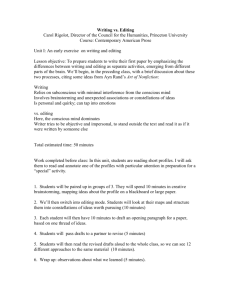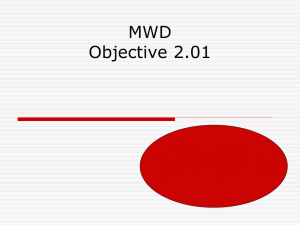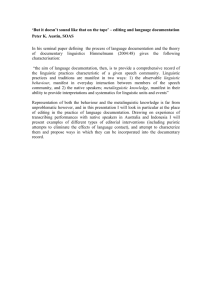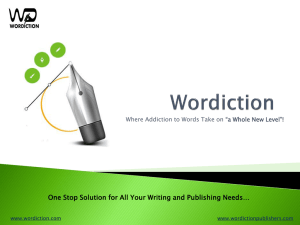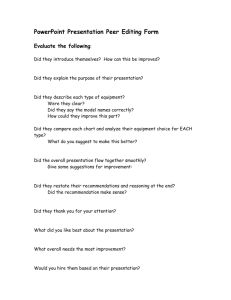PPT - Hans Rausing Endangered Languages Project
advertisement
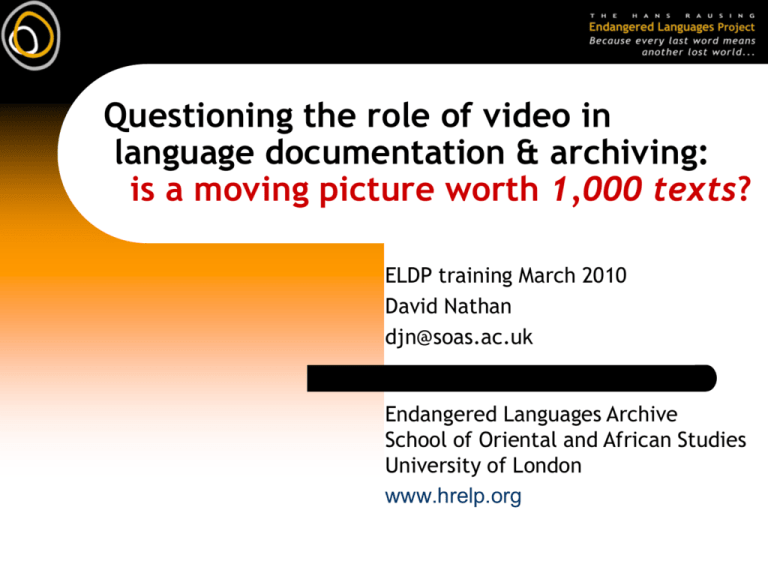
Questioning the role of video in language documentation & archiving: is a moving picture worth 1,000 texts? ELDP training March 2010 David Nathan djn@soas.ac.uk Endangered Languages Archive School of Oriental and African Studies University of London www.hrelp.org The rise and rise of video Increase in claims about video Rise from about 25% to 75% of ELDP applicants ELDP Panel has been demanding that some applicants make video Themes Goals and methodology of language documentation One size fits all The nature of the video medium Uninventing the massage Workflow and workload Disorder of magnitudes Community skills and needs On Hippocrisy Data portability and archiving Handling the bytes that feed Goals and methodology of language documentation One size fits all Himmelman: The core of a language documentation, then, is constituted by a comprehensive and representative sample of communicative events as natural as possible. Given the holistic view of linguistic behavior, the ideal recording device is video recording. Goals and methodology of language documentation Cultural and cognitive aspects can be documented or augmented by video (examples from Harrison) counting methods/systems locative expressions behaviours or appearances of plants animals etc that are described as part of language-encoded knowledge: information about plant toxicity and preparation could usefully be video swimming formations (eg Marovo people of Solomon Islands who have rich set of terms for fish behaviour and its relationships to the calendar and hunting) Gila Pima (Arizona) name a plum tree "dog's testicles", and an edible banana "looks like an erection" (umm, what will the videos show?) However, David Crystal estimates that such culturally/environmentally specific aspects are only about 10% of any languages’ content Goals and methodology of language documentation Discourse and genre distinguishing participants (McConvell) transparently capturing “stories” (Wittenburg) Adding or enhancing methodology stimulus materials the camera adds theatricality (Jukes) the camera as a participant (Atkins) enhance transcription through motivating community participation Sign language work treat video as inscription cameras, lighting, orientation, clothing etc Appreciated by communities Goals and methodology of language documentation Documentation can’t aim to capture everything (Austin) And the video camera cannot (cf next section) Argument for accountability has caused confusion between events and recordings. Result: fantasy that video is what happened and provides empirical evidence for all kinds of claims Argument: video can do X => we should do video fails without goals and methodology for X Many pro-video arguments could be equally applied to capturing other phenomena in other media: e.g. palatography collecting other text-based metadata eg on social setting Goals and methodology of language documentation There must be different methodologies (linguistic AND video) for different purposes (cf. sign) Himmelmann: [each potential discipline’s usages] influence the recording and presentation of the data inasmuch as certain kinds of information are indispensable for a given analytical procedure (no phonetic analysis is possible without some high-quality sound recording, no analysis of gestures is possible without videotaping, etc.) Goals and methodology of language documentation So if there are distinct methodologies for different purposes (e.g. sign) how adequate could a generic video be? how can video serve purposes that documenters don’t have? Goals and methodology of language documentation Explicit claimed purposes for video: In ELDP applications, many applicants request funds for video equipment but have no video-related documentation goals vs Video exponents describe the potential of video but few documenters actually have these goals Goals and methodology of language documentation Many phenomena can't be represented (cf Harrison): complex family structures and their terminologies changes in moon shape and phase (better as still photos or diagrams); other calendric and geographic expressions time and distance eg Tofa (Siberia) have words for the distance you can cover in a day on reindeer back morphological, grammatical and most lexical information (also relationships, staging, motivations, histories...) Goals and methodology of language documentation Community-orientation community oriented content members will best know what/how to shoot why should linguist shoot video at all? Goals and methodology of language documentation Video footage is not data video less “authentic” than audio - it frames with a hard edge rather than “listens” to an environment video is more bounded, more intentional than audio selection (time/space), point of view etc video content is multifaceted Video data example - traffic camera nature of data defined informs methodological choices for capture of data The nature of the video medium Uninventing the massage Video is compelling, holistic, humanistic Video “tells a story” much of what we want to capture is already a story (Wittenburg) There is a filmic language for telling stories derives from human perception and narrative, plus 100 years of cinematic evolution Filmmakers “pour scorn” on film-as-truth (Weaver) The nature of the video medium “Shoot to edit” - dictum of filmmakers more than a recommendation for good filming, a diagnostic for whole approach implies a view to methodology and outputs ethics inform editing, they do not exclude it Limits: maximal: storyboards (pre-planned action and shots) minimal: one that generates data - the traffic camera The nature of the video medium Filmer has to know the nature of the events (e.g. football vs. opera) Video is not ideal for spontaneous events except: bounded situations with conventions, eg. dinner party for accidental capture of “treasures” (ie home movies) Naivety of considering editing as “interference” editing is natural to the way we see and to the film medium story or message is achieved through editing linguists’ other work (from transcription to grammars) can be understood as intense, informed editing objections to editing could be diagnostic of lack of relevant methodologies/goals/skills Training required. Filmic skills must be learnt The nature of the video medium Fieldworkers’ preferences in an age obsessed with light weight and miniaturisation are opposed to methods for making good video: robust tripod things that are inevitably analogue such as lenses, lighting Workflow and workload Disorder of magnitudes Skills, workload, intrusion, volumes - all increase by orders of magnitude skills - equipment, shooting, editing, production equipment - choice, usage, maintenance power supplies capturing, conversion annotation editing, production data volumes Workflow and workload Video processing workflow (Wootton): “shoot and edit sympathetically … convert to a useful format" bringing the video into the system - ingesting temporal preprocessing - dealing with timing spatial preprocessing - dealing with sizing color correction - grading and picture quality noise removal - cleaning it up audio preparation encoding the content postprocessing and delivery Workflow and workload Annotation: could easily involve a time ratio of up to 100 (1 hour of video may take100 hours to process) in practice, most documenters do not annotate the phenomena that they did (or didn’t) identify fallacy that annotation etc can be done later video amplifies the value of event-participant knowledge Workflow and workload Data volumes, eg for a 4 GB DVD project: project files, originals, backups (for reversion), disk images 5 minutes of MPEG-2 video at DVD-equivalent quality occupies ~ 150 MB 5 minutes at DV quality (which you might use for editing), occupies ~ 1 GB (this is not studio quality which would be 5-6 GB) assuming semi-professional editing software that makes "nondestructive editing … using an EDL or reference movie that retains all the source components intact" total volume for the DVD production is ~ 100GB (which is largely the single copy of the original DV quality assets that are necessary for editing) Community skills and needs On Hippocrisy Hippocratic approach: working ‘for the benefit of the ill’ Video offers a good candidate for: community involvement skills transfer creating directly usable materials, including for revitalisation Community skills and needs ELAN isn’t a usable presentation but it can be used as editor to generate VCDs etc (Jukes) We’d need to observe what kinds of video are current and effective in the community (McGill) Can video be put in community hands (unlike other linguistic aspects) because it involves no linguistic methodology? Do we patronise a language community by not applying worked-out methods? Data portability and archiving Handling the bytes that feed (More pictures without captions / songs without titles etc) there are standards, e.g. MPEG, ELAN (eaf) professional knowledge and equipment needed for processing, encoding, migration Data portability and archiving Archivism: skewed proportion of discussion about technology instead of methodology, technique and goals technical parameters as proxy for quality and effective outcomes hides severe limitation on dissemination of “raw” video But technical advice has also been selective! Data portability and archiving Shooting technique and preservation quality: camera movement and poor picture quality can overwhelm compression algorithms so poor techniques (eg non-use of tripod, unnecessary pan or zoom, non-awareness of scene evolution) cause the same "loss of information" that has been so villified in the case of compressed audio Data portability and archiving Necessity for compression violates the whole rationale for digital preservation: MPEG conversions introduce the same “generational loss” as analogue copying. “Analogue ... generational loss is supposed to be eliminated when you record the video digitally. But this is only the case if no format conversion takes place during the digital transfer. Changing the encoding from one type to another results in generational losses even in the digital domain." format refreshment or editing for mobilisation will make reencoding inevitable Editing should be done from high resolution or uncompressed versions Data portability and archiving Storage costs may have to be revisited: if highly compressed MPEG2 no longer accepted if distributed storage strategies such as suggested in LAN 9 become commonplace, since costs vary according to scale of storage units then Wittenburg's calculations (LAN 10) will not apply Other archive costs: dissemination (genres, management of protocol) ??? ELAR holdings by data type This table analyses some data types of interest for a representative sample (70%) of holdings Date type by volume and number of files, sorted by volume Data type Volume (MB) Files audio 360,411 6,312 video 208,995 895 image 28,592 2,221 msword 223 404 pdf 196 134 eaf 33 176 text 32 781 lex 9 29 trs 5 246 xls 1 19 imdi 1 26 ELAR holdings by data type This table analyses some data types of interest for a representative sample (70%) of holdings Date type by number of files and volume, sorted by number of files Data type Files Volume (MB) audio 6,312 360,411 image 2,221 28,592 video 895 208,995 text 781 32 msword 404 223 trs 246 5 eaf 176 33 pdf 134 196 lex 29 9 imdi 26 1 xls 19 1 Conclusion Video can: add to the representational methods used by linguistics encourage us to look at diverse phenomena challenge our methodologies provide new and effective ways of disseminating language and cultural events and knowledge Conclusion A comparison: video vs multimedia why few exhortations to produce multimedia? multimedia: distinguishes medium from mode of knowledge representation richer and more explicit interleaving of various types of knowledge imposes its workload/costs in more appropriate ways Conclusion Generic, amateur video fails to respect participants by not recognising linguistic specialisation, complexity or expertise to the same degree as “real” linguistic work Naive video achieves “authenticity” mainly by not editing - and thereby not producing usable products! Conclusion There is a lot of tradition in evaluating the descriptive value of linguistic work, but little in defining the documentation value of video If video really does represent the claimed range of linguistic phenomena, it is a key mode of documentation: then documenters (and their teachers) need to pay much closer attention to goals and methodologies! It is not clear that it is linguists who should be making video
